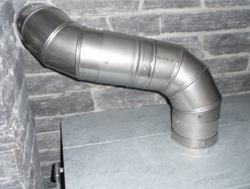I’m used to being able to research and solve technical problems, but so much of solving draft problems seems to be trial and error, so I’d appreciate input from those more experienced.
Our 28 year old house has a square clay flue liner with 6” internal dimensions. The length from thimble to chimney termination is 23’. I clean it myself every year. It’s a relatively straight shot from the top to the ash pit below the thimble. I had an endoscope down the entire length earlier this summer. There are several cracks in the upper two sections in the chimney above the roof. Other than that it looks fine.
Most of our wood stove use is in high humidity conditions slightly above the freezing point (we’re near the coast). It is our auxiliary heat source for the not infrequent winter power outages. The location has an underfloor 4” diameter PVC pipe for combustion air intake. The pipe is about 10’ long and is completely clean from one end to the other.
The wood stove that we replaced this year never had great draft. Because it’s in a relatively small room, using it would drive us out of the room fairly quickly. We replaced it with a masonry heater this summer. That has solved the problem of being able to be in the room at the same time that a fire is burning. Because it extracts more heat from the flue gases, though, the draft problem has become worse.
I’ve experimented with everything available to improve the situation “upstream” of the chimney (allowing room combustion air in, opening windows, pressurizing the house with the HRV, smaller fires at the beginning, smaller wood diameter, pre-heating the unit with electric heat, etc.). The only thing that solved the problem, completely, was the temporary installation of a tiny (0.3 amp) fan atop the chimney. So I know that installing a permanent chimney fan will solve the problem, but there are some issues with that, the main one being what happens when the power goes out just after I’ve lit a fire? I’ve been thinking about battery backup.
But, would relining the chimney with a stainless steel liner solve the draft problem and remove the need for the fan? My guess is “no”, but I can’t determine a way to figure out the answer, hence the request for input. The masonry heater manufacturer says to use a 6-8” flue. I’m fairly sure that a 6” single-wall liner isn’t going to fit inside a slightly irregular 6” ID square clay flue liner, so would require breaking that out. To use double-wall and to insulate it (both for better draft) would certainly require it. Hmmm…all that extra work and expense and it might not solve the problem.
Any thoughts, please?
Our 28 year old house has a square clay flue liner with 6” internal dimensions. The length from thimble to chimney termination is 23’. I clean it myself every year. It’s a relatively straight shot from the top to the ash pit below the thimble. I had an endoscope down the entire length earlier this summer. There are several cracks in the upper two sections in the chimney above the roof. Other than that it looks fine.
Most of our wood stove use is in high humidity conditions slightly above the freezing point (we’re near the coast). It is our auxiliary heat source for the not infrequent winter power outages. The location has an underfloor 4” diameter PVC pipe for combustion air intake. The pipe is about 10’ long and is completely clean from one end to the other.
The wood stove that we replaced this year never had great draft. Because it’s in a relatively small room, using it would drive us out of the room fairly quickly. We replaced it with a masonry heater this summer. That has solved the problem of being able to be in the room at the same time that a fire is burning. Because it extracts more heat from the flue gases, though, the draft problem has become worse.
I’ve experimented with everything available to improve the situation “upstream” of the chimney (allowing room combustion air in, opening windows, pressurizing the house with the HRV, smaller fires at the beginning, smaller wood diameter, pre-heating the unit with electric heat, etc.). The only thing that solved the problem, completely, was the temporary installation of a tiny (0.3 amp) fan atop the chimney. So I know that installing a permanent chimney fan will solve the problem, but there are some issues with that, the main one being what happens when the power goes out just after I’ve lit a fire? I’ve been thinking about battery backup.
But, would relining the chimney with a stainless steel liner solve the draft problem and remove the need for the fan? My guess is “no”, but I can’t determine a way to figure out the answer, hence the request for input. The masonry heater manufacturer says to use a 6-8” flue. I’m fairly sure that a 6” single-wall liner isn’t going to fit inside a slightly irregular 6” ID square clay flue liner, so would require breaking that out. To use double-wall and to insulate it (both for better draft) would certainly require it. Hmmm…all that extra work and expense and it might not solve the problem.
Any thoughts, please?


